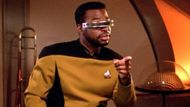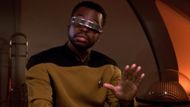If you want to talk about TV shows that really left a mark on sci-fi, you can’t skip Star Trek: The Next Generation. It was a game-changer when it hit screens back in 1987. Gene Roddenberry gave everyone an optimistic glimpse into a future where tech is awesome, nobody is a gink about your background, and everyone is busy exploring the galaxy instead of blowing it up. Not to get after-school special on you, but it changed how people thought about diversity and inclusion in nerdy spaces.
As far as the crew is concerned, you had all kinds of people up on that bridge saving the universe, looking cool in jumpsuits. But Geordi La Forge was next-level. LeVar Burton brought some serious style to the role, and it was cool seeing a blind guy run engineering on the flagship of the Federation. Instead of just getting shoved into the background, Geordi was right up front. His VISOR (Visual Instrument and Sensory Organ Replacement) made him see things nobody else could. It was hope, rep, straight-up awesome, and most importantly, it changed how disability was shown on TV.
However, around season three, the writers were thought of giving Geordi his sight back, which would have been a massive deal for the character, for the show, for the whole conversation about tech and what it means to be “normal.” They toyed with the idea, but in the end, they left Geordi as he was. This back-and-forth is something fans still argue about.
So, why did Roddenberry want Geordi on the bridge? How did his blindness drive the story forward? And why would they decide not to “fix” him, even though they totally could have?
Let’s dig in because there’s way more to this than just a cool prop and a pair of wraparound shades.
Star Trek: The Next Generation storyline and Geordi La Forge’s role

Let’s just cut to the chase — why does any of this matter? So, Star Trek: The Next Generation is set in the 24th century. You have got the USS Enterprise-D, which isn’t just any old spaceship — it is the pride of Starfleet, dashing around the galaxy to shake hands, make discoveries, and occasionally blast some enemies.
The cast includes Captain Jean-Luc Picard (Patrick Stewart), Commander William Riker (Jonathan Frakes), and the android Lieutenant Commander Data (Brent Spiner), among others. They are the work crew that somehow becomes family, arguing over philosophy one minute and saving each other the next.
Now, Geordi La Forge has been around since day one. Started as a lieutenant junior grade, flying the ship, and was born blind. But instead of letting that hold him back, he rocks this insane tech called a VISOR. It takes in all sorts of electromagnetic signals and feeds them straight to his brain. So, he is not just “seeing” — he is seeing things nobody else even knows are there. He has got it all covered, be it problems in the ship, weird energy readings, or life forms.
Making Geordi a main character was groundbreaking back in the day. Gene Roddenberry wanted to show how much better the future could be. He gave us a blind officer, not as some “inspiration” trope, but as a fierce character who is smarter than half the crew.
By season two, he is the Chief Engineer. This time, he is fixing the impossible, thinking on his feet, and kind of stealing the show. Additionally, his bromance with Data is pure gold. Those two are the heart of so many episodes — it is not even funny.
Geordi’s VISOR is the ultimate plot device. He spots things nobody else can, saves the day, and does it all while keeping his cool. Plus, he is just a genuinely solid leader, confident and encouraging. By the end of it all, Geordi is not just the tech whiz in the engine room. He is a fan favorite, mostly because he is clever, compassionate, and totally human.
Initial plans to restore Geordi La Forge’s sight in Star Trek

By the end of Star Trek: The Next Generation season 2, there was a real conversation going on — LeVar Burton and some of the writers were tossing around the idea of giving Geordi his sight back. Not just for one episode, but for good. They even dropped a hint in season 2, episode 5 (Loud as a Whisper). A deaf mediator, Riva, notices Geordi’s funky-looking VISOR and says something like:
“It's a blessing to understand we are special, each in his own way.”
In that episode, Dr. Pulaski (Diana Muldaur) offers Geordi an experimental surgery that could, maybe, possibly let him see again. Geordi doesn’t jump at it, though — he says he will think about it.
So why was this even a thing? Well, LeVar Burton disliked the VISOR. The thing squeezed his head, gave him headaches, and killed any chance of acting with his eyes. Plus, the writers were worried about Geordi getting stuck as the blind guy with the cool tech. They wanted to give him more to do, open up his storylines, and not just have every episode be Geordi's struggles with his eyesight.
Moreover, the special effects budget back then was not exactly Star Wars-level, so most of the time, we never actually got first-person VISOR view. But the rare moments when they pulled it off were super cool. Anyway, when they started brainstorming for season three, there was legit talk about making Geordi’s sight restoration a big story arc. But, in the end, it just didn’t fit with the direction the show was going.
So, Geordi kept the VISOR.
Why the idea to restore Geordi’s sight was dropped?

Even though there were a bunch of good reasons — on and off screen — to just let Geordi see already, the people behind the scenes (LeVar Burton included) ditched that idea. They have talked about it in interviews, and their arguments boil down to a few main things:
Star Trek has always been about celebrating differences, not erasing them. Fixing Geordi La Forge’s blindness would have sent the wrong message, as if you are disabled, you are not enough unless you are “cured.”
Meanwhile, a ton of fans, especially fans with disabilities or people close to that world, totally saw themselves in Geordi. He wasn’t some token character to “fix.” The idea of giving him his sight back made a lot of writers nervous, because it would basically undercut everything Star Trek was supposed to stand for.
Additionally, story-wise, Geordi’s blindness with the VISOR was a goldmine. He could catch stuff everyone else missed, such as tech glitches, weird signals, and more. It gave Star Trek: The Next Generation some fresh angles, instead of just recycling old Trek plots.
While the VISOR was a pain (literally) but Burton started to see the bigger picture. Geordi being blind actually mattered to people. Screen Rant even points out that, even though he was uncomfortable, Burton got why Geordi’s blindness and that headband-thing meant so much, especially for people craving some real, positive disabled representation on TV.
However, in Star Trek: First Contact, Geordi finally ditched that infamous VISOR for some bionic eyeballs. The movie gave it a nice in-universe reason, but the big push came from poor LeVar Burton’s sanity. He had that prop clamped to his face for seven years on Star Trek: The Next Generation and another movie. Apparently, it squeezed so hard he got headaches, could barely see, and they sometimes had to screw it into his temples.
So, the new ocular implants let Geordi do all of sci-fi stuff like zooming in, or making his pupils do that camera-aperture thing. But the real win was that LeVar could finally act with his eyes. Those contact lenses in First Contact were way more comfortable.
Meanwhile, in the Star Trek universe, Geordi swapping his VISOR for ocular implants was kind of a big flex. Not only did he keep his supercharged vision, but the new eyes came loaded with digital upgrades. Plus, remember that prior plot hole from Generations where his headgear was hacked? The implants were supposed to shut that down.
But you can tell the writers weren’t just ticking off a tech upgrade box. They wanted to make sure Geordi still felt like Geordi. He is still blind, but in the most high-tech way possible. They didn’t just give him “normal” vision, because that would’ve been a slap in the face to everything his character stood for.
The improved prosthetic made him even more of a boss now. Accessibility plus cool sci-fi tech is the Star Trek way.
